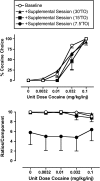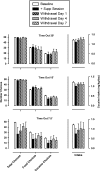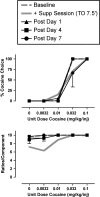Effects of extended cocaine access and cocaine withdrawal on choice between cocaine and food in rhesus monkeys
- PMID: 19776729
- PMCID: PMC2913442
- DOI: 10.1038/npp.2009.154
Effects of extended cocaine access and cocaine withdrawal on choice between cocaine and food in rhesus monkeys
Abstract
Chronic drug use may lead to sufficient drug intake to produce dependence and the emergence of abstinence signs during withdrawal. Although withdrawal can increase the reinforcing effects of some drugs (eg opioids), the impact of withdrawal on the reinforcing effects of stimulants like cocaine is less clear. This study used a novel cocaine vs food choice procedure to examine the relative reinforcing strength of cocaine before, during, and after exposure to graded levels of extended cocaine access. Responding in four rhesus monkeys was maintained by cocaine (0-0.1 mg/kg/injection) and food delivery under a concurrent-choice schedule during daily 2-h sessions. Under baseline conditions, cocaine maintained a dose-dependent increase in cocaine choice. Subsequently, subjects were exposed to and withdrawn from periods of extended cocaine access, which was accomplished by implementing daily 21-h supplemental sessions of cocaine self-administration in addition to daily choice sessions. During supplemental sessions, cocaine (0.1 mg/kg/injection) was available under a fixed-ratio 10/time-out X schedule, and the duration of the time-out was varied from 30 to 7.5 min. Cocaine intake increased 10-fold to >11 mg/kg/day during exposure to supplemental sessions with the shortest post-injection time-out. However, parameters of cocaine choice were not significantly affected either during or after extended cocaine access. These results do not support the hypothesis that cocaine withdrawal increases the reinforcing strength of cocaine. This differs from results with the opioid agonist heroin and suggests that withdrawal may have different functions in the maintenance of opioid and stimulant abuse.
Figures






References
-
- Ahmed SH, Koob GF. Transition to drug addiction: a negative reinforcement model based on an allostatic decrease in reward function. Psychopharmacology. 2005;180:473–490. - PubMed
-
- Aigner TG, Balster RL. Choice behavior in rhesus monkeys: cocaine vs food. Science. 1978;201:534–535. - PubMed
-
- Basso AM, Spina M, Rivier J, Vale W, Koob GF. Corticotropin-releasing factor antagonist attenuates the ‘anxiogenic-like' effect in the defensive burying paradigm but not in the elevated plus-maze following chronic cocaine in rats. Psychopharmacology. 1999;145:21–30. - PubMed
-
- Branch MN, Sizemore GM. Behavioral tolerance to cocaine in squirrel monkeys: acute and chronic effects on complex operant behavior. Pharmacol Biochem Behav. 1988;30:737–748. - PubMed
-
- Carrera MR, Schulteis G, Koob GF. Heroin self-administration in dependent Wistar rats: increased sensitivity to naloxone. Psychopharmacology. 1999;144:111–120. - PubMed
Publication types
MeSH terms
Substances
Grants and funding
LinkOut - more resources
Full Text Sources

